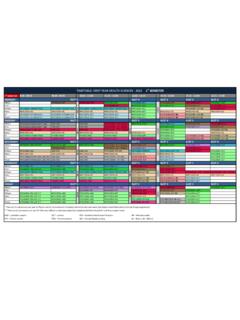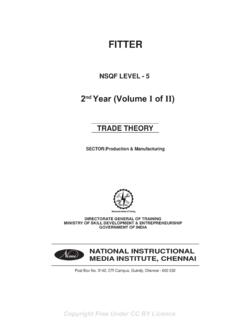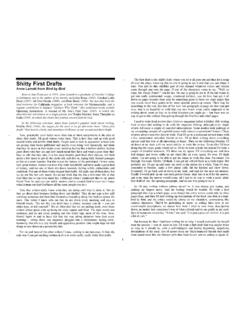Transcription of Factors Influencing College Persistence for First-Time ...
1 12 JournAl of D eVelopmenTA l eDuCATIonFactors Influencing College Persistence for First-Time StudentsBy Sheilynda Stewart, Doo Hun Lim, and JoHyun KimAbstract: Using Tinto s (1993) longitudinal model of institutional departure, this study examined demographic variables, family characteristics, precollege and College academic performance fac-tors, and extent to which mandatory placement in remedial courses predict Persistence at a public research institution. This study also examined the relationship between ACT composite scores, high school GPA, first - semester College grade point aver-ages, and Persistence . Longitudinal data with 3,213 students were analyzed using factorial analysis of variance (ANOVA), Pearson s product-moment correlations, and multiple regression analysis. Results showed significant mean differences for ethnicity, financial aid, and remedial status on Persistence .
2 High school GPA and first - semester College GPA were found to be significant predictors of Persistence . Findings indicated that traditional College students who were academically prepared to take College -level coursework were more likely to persist than students placed in mandatory remedial coursework. Implications from this study suggest that support services such as tutoring, mentoring, counseling services, early intervention systems, and financial aid assistance will improve study participants academic deficiencies and increase Persistence beyond the first the early nineteenth century, American colleges and universities addressed deficiencies in students reading, writing, and mathematics skills. A chronology of developmental education delineates a long history of academic assistance in American colleges and universities (Cohen, Brawer, & Kisker, 2013).
3 Opponents of remedial education have argued that the widespread need for remedial education at colleges and universities has ultimately increased costs to the students and taxpayers for education that should have been mastered in high school (Hoyt & Sorenson, 2001; Terry, 2007). In this study, remedial education is defined as coursework that compensates for a lack of basic reading, writ-ing, and arithmetic skills necessary to succeed in a College -level course. Student Persistence is a major concern for most universities. According to the National Center for Educational Statistics (2011), 23% of full-time students who entered a four- year institution for the first time in 2008 did not remain at their College in the subsequent fall. A major issue facing higher education institu-tions serving underprepared and underrepresented populations is addressing transition issues for tra-ditional aged College students during the first year (Raab & Adam, 2005).
4 Researchers have become increasingly aware of the social and economic fac-tors that contribute to how well students transition from secondary to postsecondary institutions. If students do not resolve transition issues in the first year , especially during the first semester , the likelihood of persisting at the same institution is diminished, which affects future enrollments and graduation rates (Raab & Adam, 2005). Evidence suggests that academic intervention programs such as tutoring programs, academic advising, and counseling programs have at least a modest effect with helping students overcome precollege academic deficiencies and associated disadvantages (Pascarella & Terenzini, 2005). Findings from previous research (Braley & Ogden, 1997; Easterling, Patten, & Krile, 1995; Weissman, Silke, & Bulakowski, 1997) show that remediation efforts at higher education institutions provide short-term benefits by increasing academic per-formance for underprepared students within the first year in College and also provide long-term retention benefits ranging from 2 to 6 ReviewResearch conducted by ACT (2007) from their curriculum-based measure of College readiness benchmark scores have shown that if high school students are ready for College , then dropout rates and remediation costs are reduced.
5 Subsequently, more students will persist and graduate from of Remediation on PersistenceAmong numerous studies investigating the effect of placement in remedial coursework, findings and conclusions have been mixed. As an example, Hoyt s (1999) study revealed that remediation had no significant relationship with persis-tence. Research by Livingston (2007) examined sheilynda stewartDirector, Institutional researcheast Central university1100 e. 14th streetAda, oK Hun limAssociate professor, educational leadership and policy studiesuniversity of oklahoma820 Van Vleet oval, room 208norman, oK 73019 JoHyun KimAssistant professor, Department of educational leadershipTexas A&m university-CommerceYoung education north 124 Commerce, TX 75428If students do not resolve transition issues in the first likelihood of persisting at the same institution is 38, Issue 3 spr Ing 2015 13demographic, financial, and educational Factors related to graduation from Virginia s public col-leges and universities.
6 His analysis of the 1993 and 1997 admission cohorts using regression analysis revealed that students who were not enrolled in remedial courses were more likely to persist and graduate than students who were enrolled in remedial courses. In another study, Adelman (1998) examined the relationship between a student s need for reme-dial courses and degree completion by examin-ing College transcripts of high school students who graduated in 1982. Findings from his study revealed that 60% of College students who did not take remedial courses and 55% of those students who completed only one remedial course earned a College degree by the age of 30. In contrast, only 35% of the students who completed five or more remedial courses earned either a bachelor s or associate s degree. Findings from a recent study by Adelman (2006) showed that the number of remedial courses taken influenced the time to degree from College , but he did not find a significant relationship between remedial courses taken and graduation with a bachelor s of Student Demographic Attributes on PersistenceVarying results about the effects of gender differ-ences on Persistence are reflected in the literature.
7 Corbett, Hill, and Rose (2008) revealed that women attend and graduate from College at higher rates than their male peers. Results from a study by Hagedorn (2005) revealed that graduation rates for female students were 20% higher than male stu-dents. In contrast, findings from other researchers (Horn, Peter, & Rooney, 2002; Pritchard & Wilson, 2003) revealed that gender did not influence persis-tence. Findings from Reason (2003) revealed little or no significant difference between the genders on dropout behavior. There have also been varying results from studies conducted on the impact of ethnic differ-ences on Persistence . Hagedorn, Maxwell, and Hampton (2001) reported that Black students had lower Persistence rates than White students. Braxton, Duster, and Pascarella (1988) revealed that minority students were more likely to depart from College than their peers.
8 In contrast, research findings utilizing national samples of students attending four- year colleges disclosed greater per-sistence of Black students at four- year institutions than White students after controlling for socio-economic status, aspiration, and past academic achievement (Astin, 1971; Peng & Fetters, 1978). Findings from a study by Pascarella and Terenzini (1978) revealed significant and unique interactions in gender, major, and race/ethnicity on dropping out volu nta r i of Precollege Academic Experiences on PersistenceHigh school grades and scholastic measures are recognized by many researchers as the most reliable predictors of academic achievement and College Persistence (Allen, Robbins, Casillas, & Oh, 2008; Astin, 1971, 1973, 1997; Hoffman & Lowitzi, 2005). Researchers have found high school grades to be stronger predictors of College academic achieve-ment than any other Factors (Hoffman & Lowitzi, 2005; Livingston, 2007; Munro, 1981; Zheng, Saunders, Shelley, & Whalen, 2002).
9 Astin (1997) analyzed data on 52,898 students attending 365 baccalaureate institutions using average high school grades to generate a regression formula to estimate institutional expected retention rates. Findings from this national longitudinal retention study revealed that high school grades are viable predictors of College Persistence . Numerous studies have revealed a positive relationship between standardized test scores, such as the SAT and ACT, and Persistence (McGrath & Braunstein, 1997; Noble, 2003; Stillman, 2007; Tracey & Robbins, 2006). However, other research-ers (Munro, 1981; Pascarella & Terenzini, 1983) indicated that standardized test scores did not have a direct link to a student s decision to persistand drop-out in College . Tracey and Robbins (2006) examined the relationship between ACT composite scores and Persistence by analyzing First-Time freshmen enroll-ment data from 87 colleges and universities from four states for students enrolled between 1994 and 2003.
10 Results from the hierarchical linear regression analysis revealed a statistically significant relation-ship between ACT scores and of Socioeconomic Status/Financial Aid on Persistence In investigating the relationship of parental income to Persistence , many research studies came to mixed conclusions. Cabrera, Castaneda, Nora, and Hengstler (1992) reported that ability to pay for College expenses can moderate the effects of other variables on Persistence . In contrast, prior research by Astin (1973) revealed that family income was not a direct factor related to College dropout behavior. Findings from Stage and Rushin s (1993) study revealed that parental income was the third-most useful factor for predicting Persistence after stu-dent high school GPA and parental educational level. Corbett, Hill, and Rose (2008) showed that disparities by race/ethnicity and family income specifically for African-American, Hispanic, and low-income students on Persistence were present.
















